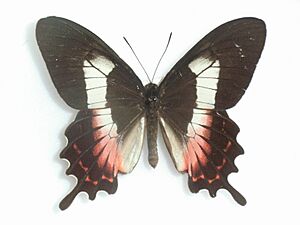Fluminense swallowtail facts for kids
Quick facts for kids Fluminense swallowtail |
|
|---|---|
 |
|
| Conservation status | |
| Scientific classification |
The Fluminense swallowtail (scientific name: Parides ascanius) is a beautiful type of butterfly. It belongs to the Papilionidae family, also known as the swallowtail butterflies. This special butterfly lives only in Brazil, in specific areas like Atafona and Itaguaí. This means it is endemic to these places, found nowhere else in the world!
What it Looks Like
The Fluminense swallowtail is easy to spot! It has a unique tail shape, which looks a bit like a spoon. Both male and female butterflies look quite similar.
A wide white band crosses both of its wings. On the back wings, this band often has a reddish color. Male butterflies have a special fold on their back wings, covered with soft white "wool."
When this butterfly is a larva (a caterpillar), it is light brown. It has small, pointed bumps all over its body.
Life Cycle and Habits
The young Fluminense swallowtail larvae can be found from October to April. These caterpillars are very picky eaters! They only munch on the leaves of a specific plant called Aristolochia macroura. This plant grows in the butterfly's favorite wet, marshy homes.
Once they grow into adult butterflies, they fly around all year long. Adult butterflies love to drink nectar from flowers. Their favorite flower is the Lantana camara, which is part of the Verbenaceae plant family.
Where its Name Comes From
The scientific name, Parides ascanius, comes from an old story. In Roman myths, Ascanius was a legendary king.
The common name, "Fluminense," is a special word. It is used for people who live in the state of Rio de Janeiro, Brazil. This is where the butterfly is found!


